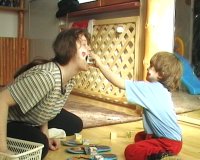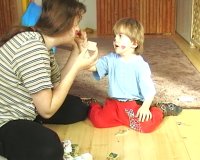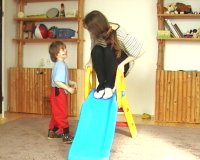Following facts are partially from official
Son-Rise page, and partially from our own experience in the
Son-Rise Start-Up course. You can find more information about
the course here.
These are the basic principles of the Son-Rise therapy:
-
 Employing
a nonjudgmental and optimistic attitude: child knows very
well when we judge his world. He has his 'tantras', ritualistic behaviors and
we label them as bad. In fact, every behavior has its reason. Maybe we don't
know it, but reason always exists. No behavior of the autistic child is bad!
When we are forbidding behaviors which our child is keen on, when we are
sending him/her signal 'your world is bad, only ours is good', why
he/she would want to communicate with us? The way from this circle is
inside us - when we adopt his behavior without judgments, when we are
content with him also when he doesn't behave like we would like, we create
the environment of freedom. There the interest in other
person has the chance to be born.
Employing
a nonjudgmental and optimistic attitude: child knows very
well when we judge his world. He has his 'tantras', ritualistic behaviors and
we label them as bad. In fact, every behavior has its reason. Maybe we don't
know it, but reason always exists. No behavior of the autistic child is bad!
When we are forbidding behaviors which our child is keen on, when we are
sending him/her signal 'your world is bad, only ours is good', why
he/she would want to communicate with us? The way from this circle is
inside us - when we adopt his behavior without judgments, when we are
content with him also when he doesn't behave like we would like, we create
the environment of freedom. There the interest in other
person has the chance to be born.
-
Joining the world of child - repeating his ritualistic behaviors: our
child does what he knows. If he doesn't communicate, probably doesn't know
how. By joining his world, we have a chance to understand him and show him that
he is not alone. By repeating his behaviors, showing that we like it, we will
show that it it is worth trying to percieve other person. After
that, we have a chance to show him that our world is worth the effort. Eye
contact with our autistic child begins after entering his world and
deepens by maximal and excitefull encouradgement of the eye contact.
-
 Utilizing
child's motivation:if the child doesn't want, we
achieve nothing. What with that? To force the child? The result will be
the cover without contents. The only chance is to work with child's own
motivation. When one wants, he can do miracles. When child is captured by
therapist and has the eye contact already, we work with his motivation. We play
with the toy he likes and it can encorage him to new performances.
Utilizing
child's motivation:if the child doesn't want, we
achieve nothing. What with that? To force the child? The result will be
the cover without contents. The only chance is to work with child's own
motivation. When one wants, he can do miracles. When child is captured by
therapist and has the eye contact already, we work with his motivation. We play
with the toy he likes and it can encorage him to new performances.
-
Teaching through interactive play: when child has fun and enjoys
the game, he likes it - otherwise he goes back into his safe
world. Endurance is crucial here - it can take months before child begins
to react.
-
Energy, excitement and enthusiasm: one of the basic components of
Son-Rise therapy. When we don't like the game, the child will see it. If we
don't believe that change is possible, we never reach it. We celebrate all
minor changes. We know that things simple for us are very komplex and difficult
for our child. When our child says "eee" after several months effort, it is
time for family celebration!
-
 Parent
as a most important person for the child: Son-Rise founders
believe in parents. There is nobody more loving, more close and able to work
with child 12 hours daily and not see it as a sacrifice, but as an excellent
opportunity. Parent is able to endure also when he/she sees no change. In fact
one of crucial things is belief that our child can get out of autism. We
want everything, but need nothing. We will love our child also if he
doesn't change at all.
Parent
as a most important person for the child: Son-Rise founders
believe in parents. There is nobody more loving, more close and able to work
with child 12 hours daily and not see it as a sacrifice, but as an excellent
opportunity. Parent is able to endure also when he/she sees no change. In fact
one of crucial things is belief that our child can get out of autism. We
want everything, but need nothing. We will love our child also if he
doesn't change at all.
-
Creating the safe working area with minimum distractions: autistic
child is overstimulated. By creating an distraction-free environment, we
help him to percieve the world, understand it and we have a chance to offer him
an interaction with other people. Son-Rise therapy takes place in a special
playroom. Parent or therapist is the most interesting object in the playroom.
Parents need to create one room at home - the playroom for therapy. It has some
principles: it has to be safe, without distractions such as paintings. It
should not contain anything what can lead to any forbiddance, there should be
no "No" in playroom. The child will be our leader, we will not use our
authority. It should contain only toys which can be used for practise of
communication and interaction. But every autistic child is different, so also
playroom differs for each child.
The therapy itself consists at the beginning mainly of repetition of child's
behavior. It depends on child - how it percieves the world. First step is
mostly joining the world of child. Instead of delivering him an information
that his behavior is bad, we express that we love him, we are satisfied with
him and we want to be close to him.
When the contact between parent and child is present, otner techniques
come. As we play, we are maximizing the eye contact, communication, later
imagination... everything what is difficult for child. Enthusiasm, excitement
and commendations are inseparable part of play.
This therapy goes ideally 8-12 hours daily! And mostly for few years. But less
is yet better than nothing.